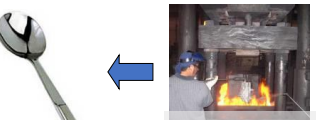A Metal is a material
when freshly prepared, polished, or
fractured, shows a lustrous
appearance,
and conducts electricity and heat
relatively well.
malleable
they can be hammered into
thin sheets
ductile
can be drawn into
wires
A metal may be a
chemical
element such as iron, or an alloy such
as
stainless steel.
Stone Age
These metallurgy techniques began in the
Neolithic stage
(towards the end of the stone age) c. 7500 BC
Cold
Working
Annealing
Smelting
Lost Wax Casting
Bronze Age
c 4500 BC Being more robust than
copper, bronze enabled people
to
create more durable metal objects
Iron Age
Iron artifacts were found as early as
2500 BC
Present Age
Aluminum,
Plastics, Ceramics,
Composites,
Semiconductors,
Super-alloys
Gold
Historically, used for decorative purpose no utilitarian value
•
Currently still being used as jewelry but also widely used in
electronic products
Copper
• A ductile material, resistant to
corrosion with very high
thermal and
electrical conductivity.
Silver
Similar use to gold
decorative jewelry and
measure of
wealth
• Phoenicians used silver
for anchors
Lead
• Galena was burnt to obtain
silver
• Used as writing
material,
currency and construction
material.
Iron, Smelted
Iron from meteorites were used as early as 3500 BC
(found with
7% Ni)
Mercury
• used as amalgam – used to dissolve
silver and gold.
•
Used by Chinese to prolong life, heal
fractures and maintain good
health
(now known as a health hazard)
Tin
Used historically with copper to form bronze alloys.
Increases hardness, lowers melting
temperature and improves
efficiency during casting.
Material Evidences
artifacts of jars, plates,
arrowheads, axes and other
farm
implements, as well as the walls of
prehistoric caves
• Georgius Agricola (1494 to 1555)
De Re Metallica (On the Nature of
Metals)
Vannoccio Biringuccio (1480 to
c.1539)
• De La Pirotechnia (Concerning
Pyrotechnics)
Metallurgy
The art and science of extracting and
refining metals from
primary and
secondary sources to characterize,
process, and
fabricate for application
and use at a profit and with
utmost
consideration of the environment
Minerals
naturally occurring,
• inorganically formed,
• homogenous
solid
• definite chemical composition
and an orderly crystalline
structure
Ore
Is a mineral deposit w/c can be
ECONOMICALLY EXPLOITED to
become
a source or supply of a particular
material
Concentrate
valuable minerals
obtained from the
recovery processes
Gangue
• Minerals of no value
Ore Dressing
• preparation required before the
extraction process
Recovery or Winning
• Process involving the production or
recovery of pure metal
Grade/Assay
• Metal content or measure of
the concentration of metal.
•
Used to ascertain the content
of valuable metal in ore
Cut-off Grade
• lowest grade of mineralized
material considered economic
Native Ores
metal is present in elementary form
• Gold, Copper, Silver
Sulphide Ores
contain metals as sulphide
• CuFeS2, Cu2S,
Oxidized Ores
Valuable mineral may be present as oxide, sulfide, sulphates, silicates,
carbonates
Unit Operations
• individual sequential steps in
producing metal from the
ore
involving purely physical
changes
Unit Processes
• individual sequential steps in
producing a metal involving
chemical reactions and/or changes in the state of
aggregation

Minerals processing

Metal Purification

Forming Processes

Fabrication Techniques